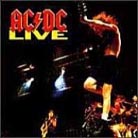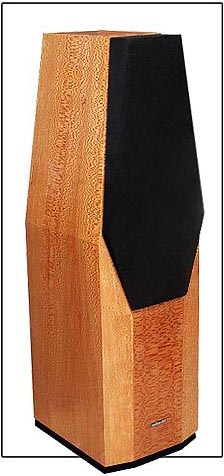 |
|||||||||||||||||||||
| Be it plucked double basses resonating through a large venue as per Paganini's "Moto Perpetuo" from Sony's Rostropovich - Return to Russia [Sony Classical SK 45836] or pounding bass drums from AC/DC's remaster of the 1992 release AC/DC Live [EPIC E2K 80215], the Bolero was completely satisfying. The Dynaudio T330D Esotar tweeter has a stellar reputation and many call it the finest tweeter extant. Last year, I was fortunate enough to have an extended cohabitation with another excellent little speaker that is known for making good use of it: The Merlin VSM Millennium. |
|||||||||||||||||||||
 |
|||||||||||||||||||||
 |
|||||||||||||||||||||
 |
For my money though, the Bolero utilizes the driver better. It could be the way the tweeter is implemented; it could be that the tweeter is just better balanced in the warmer, more robust and extended Bolero - but I found that the Esotar sounded more relaxed in the Bolero. It was almost as if the Esotar was trying too hard to make a case for itself in the Merlin while the Bolero allowed it to forget its own hype and just sing. The Bolero's treble is extended and very detailed, yet unfailingly composed and musical. And it retains that composure at what I consider loud levels, too. It takes on no edge or prominence. Like the energizer bunny, it just keeps on going. |
||||||||||||||||||||
And when this stellar treble balance is combined with an unusually dynamic bass, I found that the Boleros could be cranked loud without any sign of distress. And that's a good thing because if the Bolero is going to be criticized in any area, it'll be for its civility. If you have an overdamped room, I'll tell you right now that the Boleros probably won't be for you. Check out the La Folia or Sonata III instead. If you own tubes or any other components that in any way exhibit a stereotypically warm and romantic presentation through the upper mids, the Boleros probably won't gel for you unless you also happen to have a reciprocally live room or source. Try another Silverline model. Ditto if you're looking for lean and mean. |
 |
||||||||||||||||||||
|
Copyrighted property of Eveready Battery Co.
|
|||||||||||||||||||||
|
|
|||||||||||||||||||||
Not surprisingly for a speaker with such a relaxed character, prepare for a soundstage that falls behind the Boleros. If you are looking for a presentation that leaps forth from the speakers, try something else. But if you prefer one that starts at the speakers and falls back melting the room's rear walls, try the Boleros. On classical music, they provided a superior and realistic view on the orchestra. I was impressed both by the depth of the soundstage and the scale on Carl Orff's Carmina Burana [RCA Red Seal 09026-61673-2]. The choral passages sounded huge yet the soloists were presented with pin-point accuracy on a properly and remotely located stage. Eva Cassidy's Live At Blues Alley [Blix Street G2-10046] was also extraordinarily well served, conjuring up a deep and dark stage with plenty of space between the musicians and me to allow easy access to the bar. |
 |
||||||||||||||||||||
 |
|||||||||||||||||||||
|
|
|||||||||||||||||||||
While they certainly please and on occasion surprise with muscle and power unexpected of a speaker of such a laid-back demeanor, they will more likely capture and hold your attention with an almost transcendental communication of everything about the music that's important to the soul. Sibling Rivalry Having recently reviewed the Bolero's less expensive Sonata Series III sibling, I suppose a few words of comparison are in order. Of the two, the Bolero would have to be termed the more refined speaker. It has a slightly smoother and more naturally relaxed treble that rarely draws attention to itself. In terms of bass performance, the two were very similar though at times I found myself wondering if the Sonata III could truly match the Bolero for sheer slam. It might, but I'd have to hear the Sonata III again to be sure. Throughout the upper bass and lower mids, I find the Bolero slightly leaner and neater than the Sonatas. Once optimally set up, both speakers sound clean and fast with no congestion to speak of but I discovered that locating the optimum position within the room was a little easier with the Boleros. While completely suitable for larger rooms, I think the Boleros may work even better than the Sonata IIIs in smaller spaces. |
|||||||||||||||||||||
|
|
 |
||||||||||||||||||||
 |
Complementing the Bolero's basic personality are other traits that make them exceedingly easy to live with. For one, there is their relative efficiency. Silverline's recommendation for a minimum of 15 watts is a good one although I derived terrific pleasure from the 6wpc Art Audio Symphony II in my smaller room. The mild-mannered midrange is beautifully melded to the deceptively detailed and extended treble on one end and a wonderfully balanced and articulate bass on the other. Even the speaker's understated size belied a big open sound with both large-scale orchestral music and hard driving Rock. In a lot of ways, there are the Silverline Bolero loudspeakers and then there's everything else. And once you've had your fill of everything else, seek out a pair of Boleros and relocate your sound room to somewhere permanently south where the climate is mellow and the nights are long. |
||||||||||||||||||||
 |
|||||||||||||||||||||
 |
|||||||||||||||||||||
|
Manufacturer's website
|
|||||||||||||||||||||
 |
|||||||||||||||||||||